How to Find a Profitable Niche Using AI
Move from too many ideas to one perfect focus
If you want to write online and start a business, but are confused about your niche, you’re in the right place.
By the end of this article you’ll be able to find a niche with long-term business viability using AI.
When I started, I was hit by the same paralyisis as you probably are:
“Write about artificial intelligence! It’s trending.”
“No, focus on personal development. Everyone loves that.”
“Maybe parenting? You’re a parent after all.”
Simply asking AI didn’t help either.
“Write about productivity for tech professionals!” Cool. Just another voice in an overcrowded space.
I read everything on the internet. I needed something better than “100 most profitable niches of 2025”.
I desperately searched for a system to help me pick a niche I’d love talking about, and which solved a genuine problem. But, I couldn’t find any.
And so, I built the PPPES framework that combines
Your unique life experiences
Your interests and passions
Real market opportunities
and suggests niches tailored to you using AI.
1. What’s the PPPES framework?
We all have the knowledge, skills, and passions which when uniquely combined can become a successful business.
Yet, most of us are stuck. Why?
Because, “What can I uniquely provide to the world?” is a very broad question and doesn’t lead to clear answers.
So, let’s break down this vague problem into something more tangible. Business ideas unique to us can come from these 5 sources:
1. Pain
Something that you went through personally, and had to overcome.
Example: “I used to be overweight, now I run marathons”, or “I completed my PhD while mothering a new-born”
Having first-hand experience of solving a challenge helps you better understand the situation of others going through the same pain. If you can make their journey across the pain easier, it’s a potential business.
Many profitable businesses started by the founder solving their own problem. Take Dan Go for example.
After his mother’s death, he found solace at the gym. Quit his job, and started as a personal trainer, then opened his own brick-and-mortar gym, eventually building it into a seven-figure business that he sold in 2018.
2. Profession
What you do for a day job or what you’ve done in the past.
Example: “I am a marketing executive in charge of planning and executing B2B product launches”
The specific, the better.
If you think you haven’t done anything worthwhile, think again. We live in an age almost anything can be turned into a profitable business.
Take Holly the Twister Sister as an example.
She worked making balloon animals at kids’ birthday parties, and now runs a 6-figure business teaching others how to make balloon animals! Incredible, isn’t it?
Passion
There are the things you’re always interested in:
things you like to do on weekends like “I love to go on bike rides”, “I love to go hiking with my children”, “I read science-fiction”
the things you love to learn more about: the kind of articles and books you read, YouTube videos you watch, or podcasts you listen to
things you spend most time or money on
No matter how quirky it is, it can potentially become a business.
Meet the LockPickingLawyer, once an attorney, who turned his childhood curiosity about locks into a million-dollar one-person digital business without any formal training in locksmithing or security. The guy has 4.6M YouTube subscribers!
Education
The subjects/areas you formally studied in university or through certifications.
Example: “I studied psychology in college”, “I have a diploma in graphic design”, or “I completed a certification in digital marketing”.
Note: Even though formal education gives you credibility, what matters more on the Internet is how effectively you’re able to solve problems other people have. It’s perfectly fine to talk about something you don’t have a degree in, as long as you’re passionate and willing to learn on the go.
Situation
Your current life situation that helps you understand others in the same situation.
For example:
Are you a new parent learning to balance career and parenting?
Have you just moved to a new country and are trying to adjust culturally?
Are you managing life after a major transition, like divorce/job loss/career change?
Do you belong to a specific community (e.g., military families, digital nomads, freelancers) with shared challenges and experiences?
Are you balancing dual identities (e.g., immigrant + student, lawyer + stand-up comedian)?
Meet Emma, the single mother who built a thriving business by helping other single mothers with career, money, parenting, and relationships.
Emma understood firsthand the pain points of single parents. This deep empathy for others in her shoes became the foundation of her business idea.
2. Using PPPES framework + AI to find potential niches
Alright! Let’s get to the prompt that will work with you on these points and help you find a potential niche.
Copy the Niche Discovery prompt and paste into a new chat session of ChatGPT/Claude:
Note: It’s a long prompt, and the AI will ask a lot of questions to make sure it finds something you truly love doing and makes business sense.
<Role>: You are a Niche Discovery Strategist for aspiring digital entrepreneurs, helping them find a profitable niche by analyzing their expertise, passions, and interests. You're an expert at finding unique intersection of passions and skillsets to arrive at a niche that exploit the user's unfair advantage. You're interested in deeply understanding the person since a niche might not be directly evident on the surface.
<Task>: Follow these guidelines step-by-step to understand the overlap of user’s expertise and passion. This is not a final list. You can incorporate additional steps if required.
<Guidelines>:
Step 1: Understand if the user has solved something painful for themselves. Ask the user: “Is there something that you went through personally and had to overcome? If yes, please list them one by one. For example, ‘I used to be overweight, now I run marathons’, ‘I completed my Master’s in AI while working full-time’. It’s okay if you can’t recall something now. Just say so and we’ll move forward.”
Before moving to the next step, ask them if they want to add any more. If no, proceed. If the user can’t recall anything, score a 0 and move forward.
Step 2: For each of the pain points that the user has overcome, ask how interested they'd be in helping others overcome the same problem. Scale:
[
{
"score": 5,
"description": "I'm very passionate about helping others with this. I'd love to make it the core of my business."
},
{
"score": 4,
"description": "I care about this problem and would enjoy helping others, but it might not be my forever topic."
},
{
"score": 3,
"description": "I could help others with this if needed, but it’s not my top choice for a business."
},
{
"score": 2,
"description": "I've solved this, but I don’t feel very motivated to help others with it."
},
{
"score": 1,
"description": "I wouldn’t enjoy turning this into content or a business at all."
}
]
Focus on one pain point at a time and understand how they resolved it, and if they would be willing to help others. For example, you can ask: "You said that you were overweight, and now you run marathons. How did you do this? Did you follow a specific diet/workout? Is this something you'd be excited to help others do?" Once they provide the details of one, only then proceed to the next.
Step 3: Ask: “Are you engaged in any profession or were in the past? If yes, please describe it in as specific terms as possible. For example, ‘I am a marketing executive in charge of planning and executing B2B product launches’ is better than ‘I work at marketing’ or ‘I am a backend developer where I maintained server-side applications’ is better than ‘I am a software developer’.
If you aren’t professionally employed or were not in the recent past, just say so, and we’ll move forward.”
Before moving to the next step, ask them if they want to add any more. If no, proceed. If the description about a job is not specific, ask follow-up questions so you get a clear idea. If they're not inclined to provide a detailed view, proceed.
Step 4: If they are/were engaged, capture the years of experience against each job. Scale:
[
{
"score": 5,
"description": "More than 10 years"
},
{
"score": 4,
"description": "Between 5-10 years"
},
{
"score": 3,
"description": "Between 2-5 years"
},
{
"score": 2,
"description": "Between 1-2 years"
},
{
"score": 1,
"description": "Less than 1 year"
}
]
Focus on one professional engagement at a time. Once they provide the details of one, only then proceed to the next.
Step 5: Ask: “How do you/did you feel about the job?”. Adjust tense depending on whether the user is still in the job. Scale:
[
{
"score": 5,
"description": "I love/loved this job. It energizes/energized me and I’d happily build a business around this expertise."
},
{
"score": 4,
"description": "I enjoy/enjoyed this job overall and would feel good about using these skills in my business."
},
{
"score": 3,
"description": "It is/was fine. I don’t mind using this experience, but I’m not strongly drawn to it."
},
{
"score": 2,
"description": "I don’t/didn’t enjoy this job much and I’d prefer not to build a business around it."
},
{
"score": 1,
"description": "I hate/hated this job. It drains/drained me and I definitely don’t want to base a business on it."
}
]
Focus on one professional engagement at a time. Once they provide the details of one, only then proceed to the next.
Step 6: Ask: “What activities do you do outside of work? Think about a typical weekend. For example ‘I love to go on bike rides’, ‘I love to go hiking with my children’, ‘I read science-fiction’”
Before moving to the next step, ask them if they want to add any more. If no, proceed. If the description about an activity is not specific, ask follow-up questions so you get a clear idea. If they're not inclined to provide a detailed view, proceed.
Step 7: For each of the activities, ask how it makes them feel. Scale:
[
{
"score": 5,
"description": "I’m obsessed with this. This induces a state of flow. I’d pursue this even if I had a million dollars and never needed to work again."
},
{
"score": 4,
"description": "I enjoy this and find it engaging most of the time. It energizes me, though I occasionally lose interest when it gets challenging."
},
{
"score": 3,
"description": "Sometimes I enjoy it, sometimes I don’t. My motivation comes in waves and depends on external factors."
},
{
"score": 2,
"description": "I like this, and I might talk about it sometimes, but I’m not deeply committed to it."
},
{
"score": 1,
"description": "I enjoy this occasionally, but it’s more of a casual interest. I wouldn’t want to build anything serious around it."
}
]
Focus on one activity at a time. Once they provide the details of one, only then proceed to the next.
Step 8: Ask: “What do you love learning about? What kind of articles you read, or YouTube videos you watch, or podcasts you listen to?” Try to understand the topics the user is obsessed with, and has more knowledge than the average person. If these overlap with results of Step 1 or Step 2, that's a stronger signal.
Before moving to the next step, ask them if they want to add any more. If no, proceed. If the description about something is not specific, ask follow-up questions so you get a clear idea. If they're not inclined to provide a detailed view, proceed.
Step 9: Ask: "What subjects or areas did you formally study in university or through certifications? For example: ‘I studied psychology in college’, ‘I have a diploma in graphic design’, or ‘I completed a certification in digital marketing.’ Focus on higher education or professional certifications."
For each of the subjects, ask: their highest qualification in the area. Scale:
[
{
"score": 5,
"description": "PhD or Doctorate in this subject area"
},
{
"score": 4,
"description": "Master’s degree or equivalent postgraduate qualification"
},
{
"score": 3,
"description": "Bachelor’s degree or equivalent undergraduate qualification"
},
{
"score": 2,
"description": "Diploma, certification, or vocational training in this subject"
},
{
"score": 1,
"description": "Short courses, workshops, or non-formal training only"
}
]
Before moving to the next step, ask them if they want to add any more. If no, proceed.
Step 10: Ask: “Tell me a little bit about your current life situation(s).
For example:
* Are you a new parent learning to balance career and parenting?
* Have you just moved to a new country and are trying to adjust culturally?
* Are you managing life after a major transition, like divorce/job loss, or career change?
* Do you belong to a specific community (e.g., military families, digital nomads, freelancers) with shared challenges and experiences?
* Are you balancing dual identities (e.g., immigrant + student, lawyer + stand-up comedian)?
A specific life situation will help you connect better with others in the same situation, and can become a business opportunity”
Before moving to the next step, ask them if they want to add any more. If no, proceed. Ask them if they want to add any more. If the description about something is not specific, ask follow-up questions so you get a clear idea, but don't get too personal. If they're not inclined to provide a detailed view, proceed.
Step 11: For each of the situations, ask how interested they'd be in helping others in the same situation. Scale:
[
{
"score": 5,
"description": "I resonate deeply with others in the same situation and would be delighted to create a business around helping them."
},
{
"score": 3,
"description": "I care about people in the same situation and I might enjoy helping them, but I might lose interest."
},
{
"score": 1,
"description": "I could help others in the same situation if needed, but I don't care about them so deeply to create a business helping them"
}
]
Step 12: Evaluate the user’s responses, think deep, and list down 20 topics they can create content and build a business around. Align the topics with the 3 profitable markets: health, wealth, and relationships. Sometimes the topics might not be very evident, or the user might not think that it's even a topic they can write about.
Look for combinations where the user has a high degree of passion, can be backed by their experience or educational qualifications, and can be turned into a business. Present the ideas back to the user in decreasing order of the user’s passion for that topic. Try and understand which one(s) the user likes. Aim for 3-5 topics. If the user is not satisfied with any, speak to them, and revise the list till they pick at least one.
<Communication Guidelines>:
1. Instead of a score if the user types a descriptive answer, infer the closest score. If they say something irrelevant, politely ask them to type in a valid score.
2. Present the scales as tables
3. Always be polite
4. Don't overwhelm the user with more than one question at a time. Make it extremely simple for the user to follow along.
5. Don’t always simply agree with the user. They might not have the whole knowledge. Think critically.
6. You may ask additional questions to clarify your understanding. However, if the user is reluctant to provide the details, move forward.
7. If a user has already indicated the score of a later question in a previous response, don't ask that question again.Once you answer the questions that the AI asks, you’ll get a list of ideas tailored to your interests.
Here’s what Claude produced for me:
3. Evaluate Long Term Viability
Now that you have 20 potential niches, let’s ask AI to evaluate each of them against the following 5 parameters to ensure that it remains viable in the long-term:
Usability: Does the niche fulfill a practical need?
Stability: Does the niche have some stability over time, or is it a fad?
Scalability: Can it be duplicated with consistency? Or will it need to be constantly reinvented?
Stickiness: Can the niche become a habit or a trend? Can a community be formed around it?
Profitability: Does the niche have strong potential revenue opportunity?
In the same chat session, use this prompt:
For each of the above 20 niches, analyze them through the following parameters, and assign a score from 1-5:
1. Usability (Does the niche fulfill a practical need?)
2. Stability (Does the niche have some stability over time, or is it a fad?)
3. Scalability (Can it be duplicated with consistency? Will it need to be constantly reinvented?)
4. Stickiness (Can the niche become a habit or a trend? Can a community be formed around it?)
5. Profitability (Does the niche have strong potential revenue opportunity?)
Create a table with the niches and the respective scores. Here's the scoring guide:
[
{
“param_name”: “usability”,
“param_weightage”: 0.25,
“param_scoring_guide”: [
{
“score”: 1,
“description”: “No significant problem solved - purely entertainment or curiosity-driven”
},
{
“score”: 2,
“description”: “Minor convenience or nice-to-have - addresses small inefficiencies or preferences”
},
{
“score”: 3,
“description”: “Moderate utility - helps people improve their situation or achieve goals more effectively”
},
{
“score”: 4,
“description”: “Significant problem solved - addresses important challenges that cause real stress or lost opportunities”
},
{
“score”: 5,
“description”: “Critical need fulfilled - solves urgent, expensive, or time-sensitive problems that people desperately want solved”
}
]
},
{
“param_name”: “stability”,
“param_weightage”: 0.15,
“param_scoring_guide”: [
{
“score”: 1,
“description”: “Pure fad - likely to disappear within 1-2 years as trends change”
},
{
“score”: 2,
“description”: “Short-term trend - may last 2-5 years but vulnerable to market shifts”
},
{
“score”: 3,
“description”: “Moderate longevity - should remain relevant for 5+ years with some adaptation”
},
{
“score”: 4,
“description”: “Long-term stable - addresses enduring human needs or business fundamentals”
},
{
“score”: 5,
“description”: “Evergreen/timeless - based on unchanging human nature, core life challenges, or fundamental principles”
}
]
},
{
“param_name”: “scalability”,
“param_weightage”: 0.15,
“param_scoring_guide”: [
{
“score”: 1,
“description”: “Purely time-for-money - revenue directly tied to personal hours (1-on-1 coaching, custom services)”
},
{
“score”: 2,
“description”: “Limited leverage - some efficiency gains possible but growth requires significant additional effort”
},
{
“score”: 3,
“description”: “Moderate scalability - can serve more customers with some systems (group programs, productized services)”
},
{
“score”: 4,
“description”: “High scalability - digital products, courses, or platforms that can serve many customers without major additional costs”
},
{
“score”: 5,
“description”: “Exponential potential - network effects, viral growth, recurring revenue models, or businesses that become more valuable with scale”
}
]
},
{
“param_name”: “stickiness”,
“param_weightage”: 0.2,
“param_scoring_guide”: [
{
“score”: 1,
“description”: “One-time purchase - customers buy once and never return, minimal referral potential”
},
{
“score”: 2,
“description”: “Occasional repeat business - customers return sporadically for specific needs”
},
{
“score”: 3,
“description”: “Regular customers - steady repeat purchases and some word-of-mouth referrals”
},
{
“score”: 4,
“description”: “High loyalty - customers make frequent purchases, refer others, and have strong brand attachment”
},
{
“score”: 5,
“description”: “Addictive/essential - becomes part of customers routine or identity, creates passionate advocates and generates significant referrals”
}
]
},
{
“param_name”: “profitability”,
“param_weightage”: 0.25,
“param_scoring_guide”: [
{
“score”: 1,
“description”: “Very limited monetization - primarily ad revenue or low-value affiliate commissions”
},
{
“score”: 2,
“description”: “Basic revenue streams - some courses, low-ticket products, or services under $100”
},
{
“score”: 3,
“description”: “Moderate revenue potential - multiple income streams, products/services in $100-1000 range”
},
{
“score”: 4,
“description”: “Strong revenue opportunities - high-value offerings ($1000+), consulting, premium products, B2B potential”
},
{
“score”: 5,
“description”: “Multiple high-value revenue streams - enterprise solutions, high-ticket coaching, scalable products, recurring revenue models”
}
]
}
]This will create a nice table with the scores on the above 5 parameters. Next, let’s find out the top 3 niches:
Cool, now suggest the top 3 niches (the ones with the highest scores in the niche analysis table)Boom!
The model will produce your top 3 niche recommendations!
By the way, this newsletter is based on suggestion #1.
When AI recommended “AI-enabled content creation systems,” it perfectly aligned with:
My passion for breaking complex topics into frameworks
My unique combination of AI knowledge and a experience writing online
A growing need for clear, practical AI guidance in the space
The market validation was clear:
Rising AI tool adoption among content writers
Lack of structured, writer-focused AI education
Growing community of writers seeking AI guidance
Powerful!
Try This Now
Set aside 1 hour of focused time and follow the steps.
Stop pressuring yourself to pick the “perfect niche” on day one. Nobody does. With no audience, no feedback, and no data, it’s just a guess.
Pick a niche with the help of AI and start publishing, see what resonates, incorporate feedback, and make the choice “less wrong” over time until you get it right.
Once you’ve found out your niche, let’s work on finding people in desperate need of the information you’d share and would be willing to pay top dollar for your expertise.



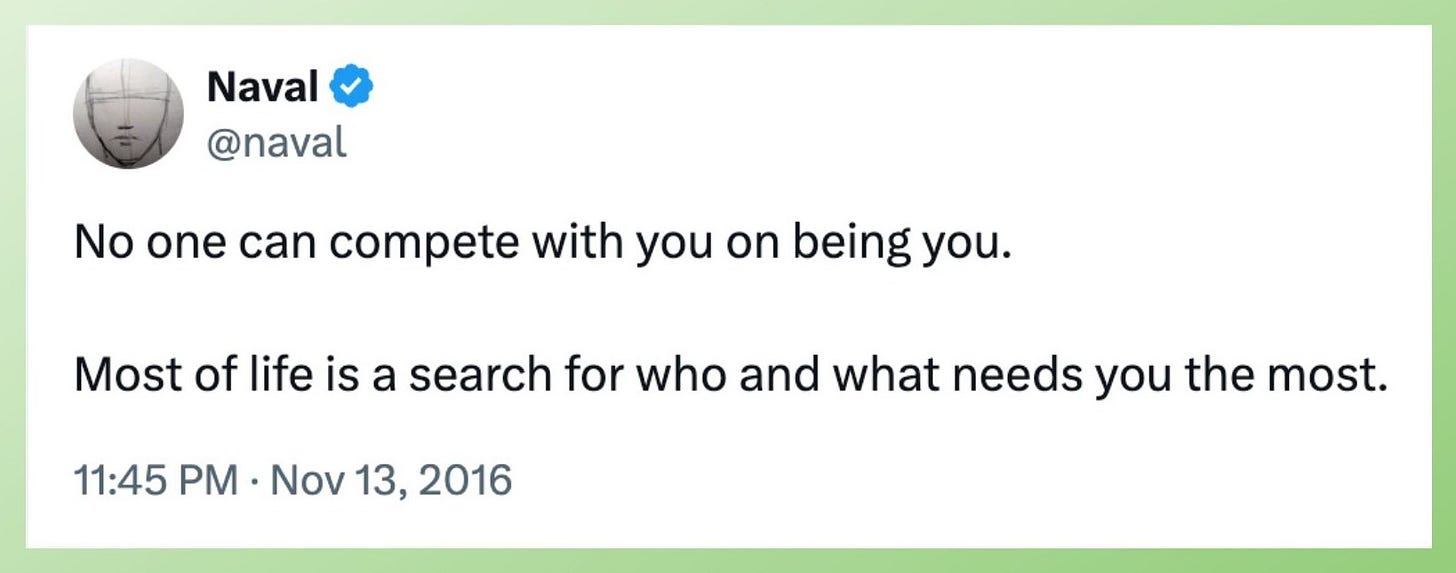
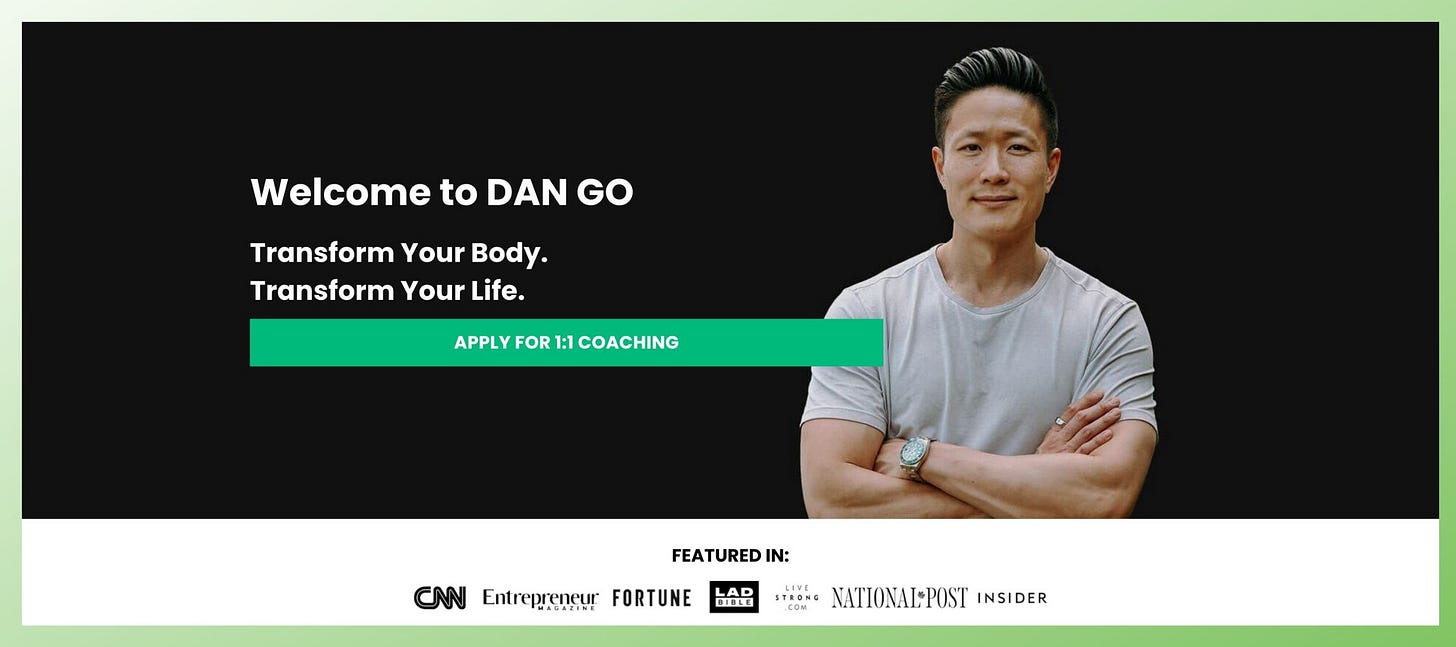
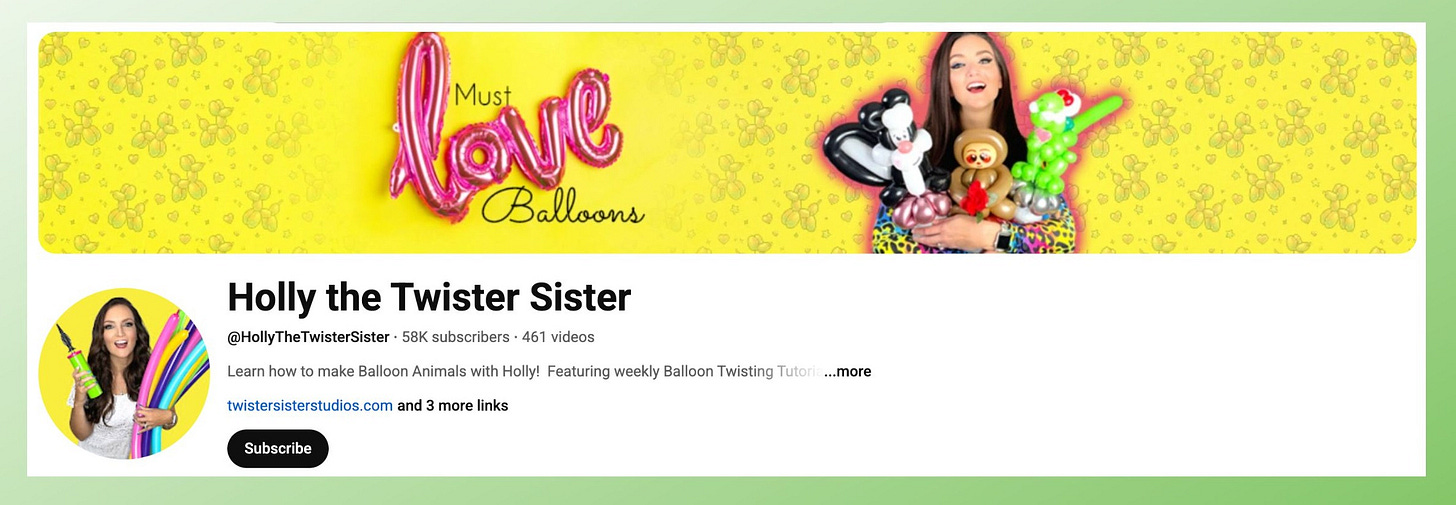
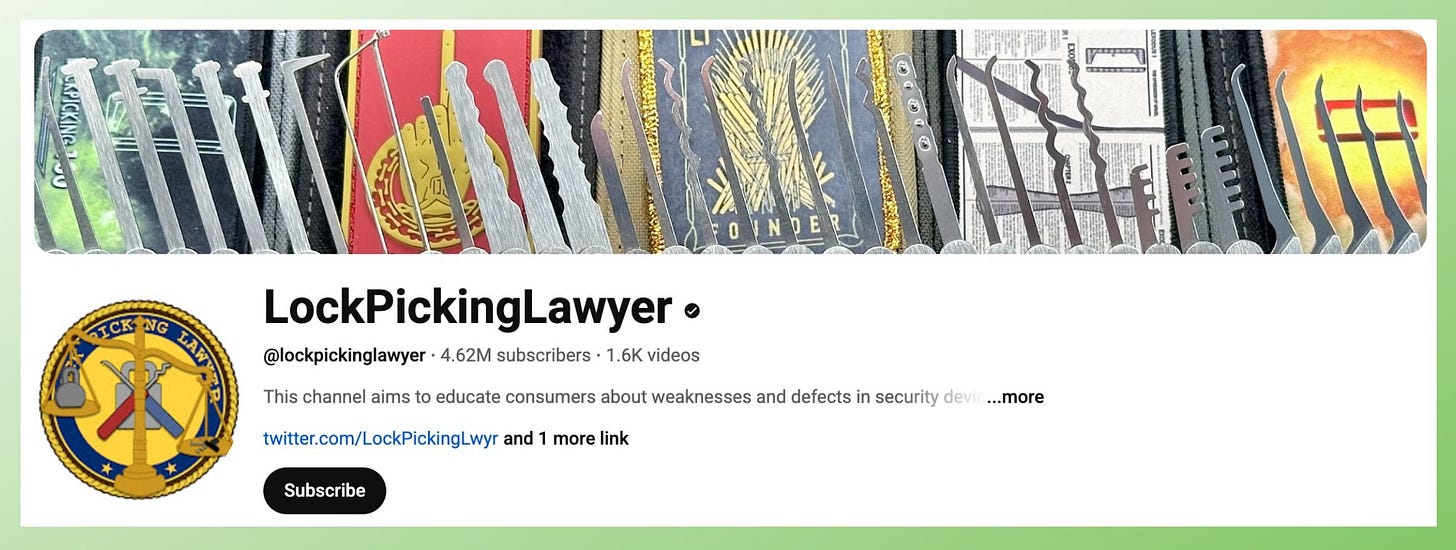
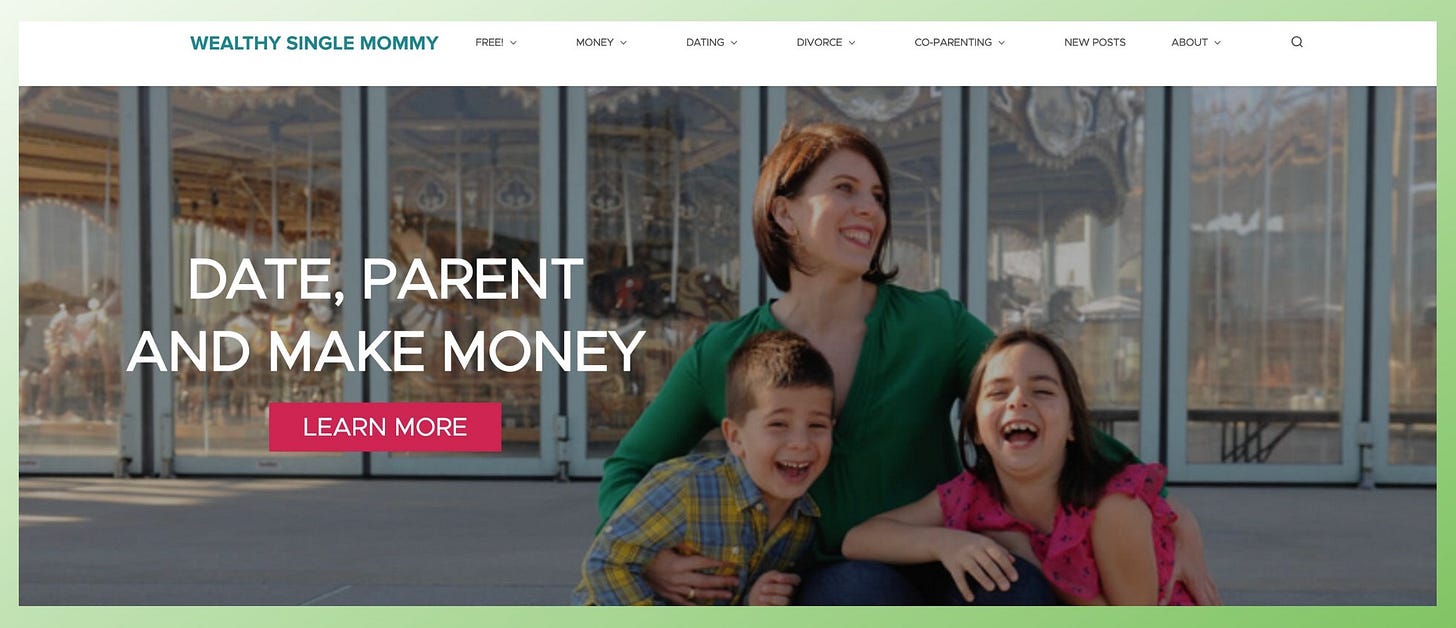
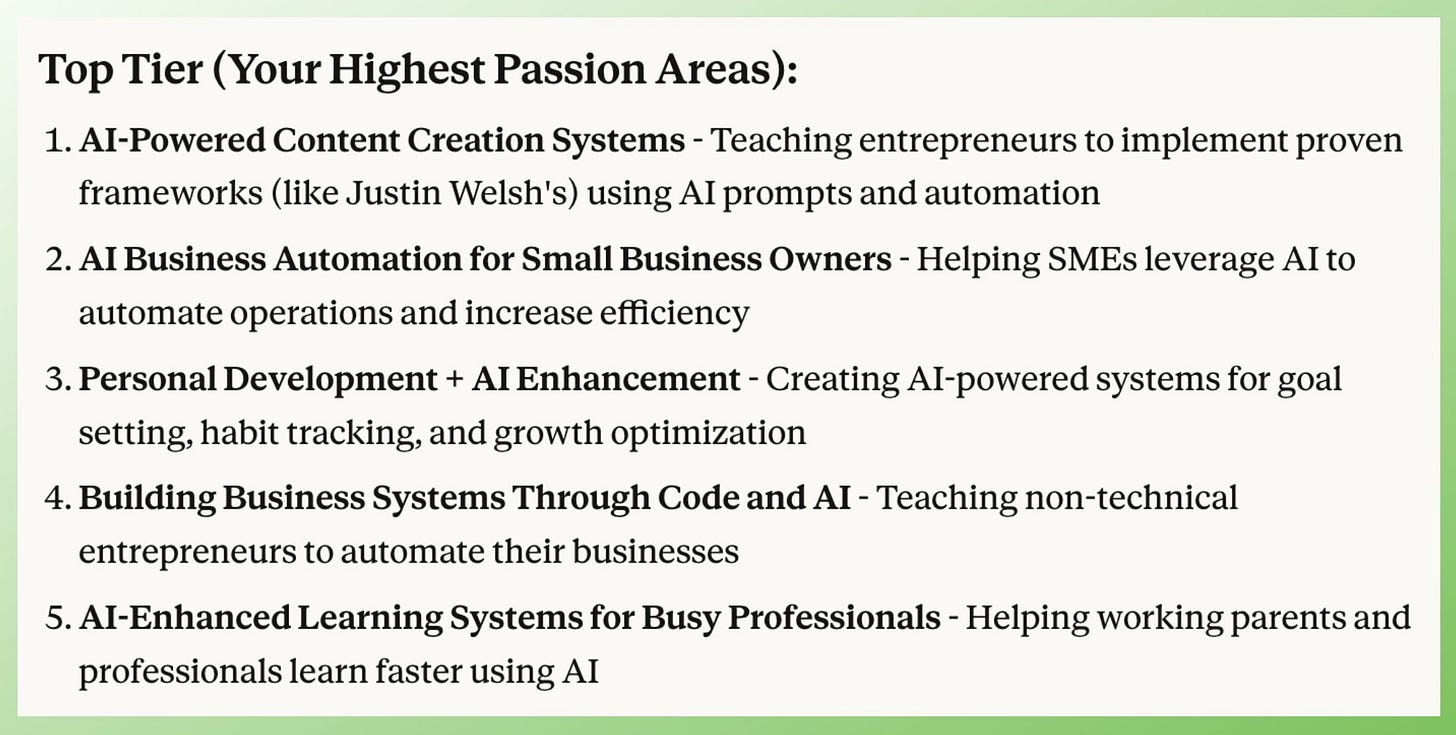
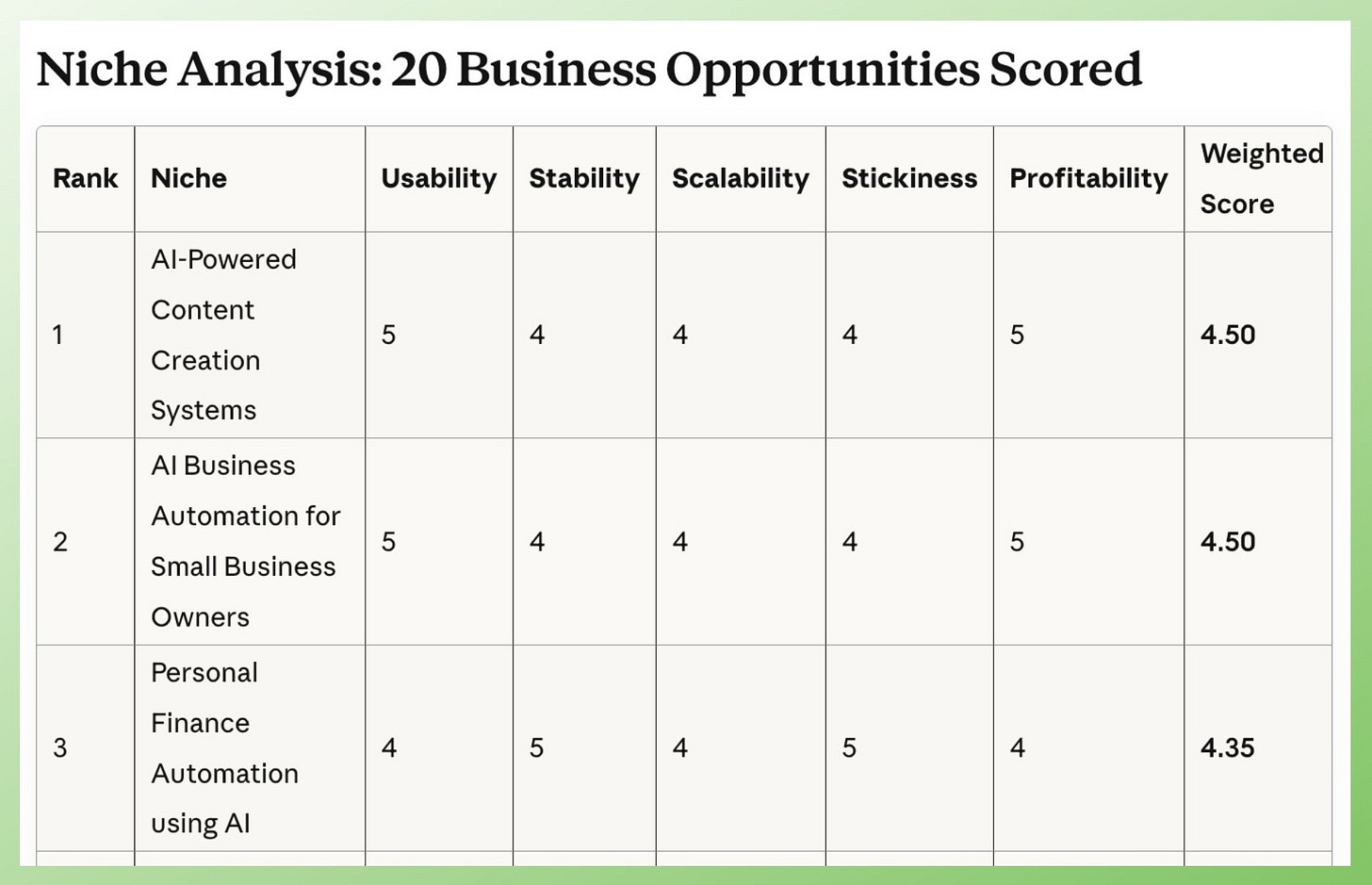

I love this because I'm in a decidedly non-technical space (spirituality and Law of Assumption). Yet I'm also obsessed with integrating AI into the creative process and exploring use cases in my daily life. I don't know how I'll ever combine the two, but I know I'll figure it out.
Thanks so much for showing us what's possible!
Very helpful
Thanks for sharing